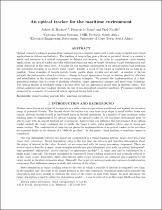JavaScript is disabled for your browser. Some features of this site may not work without it.
- ResearchSpace
- →
- Research Publications/Outputs
- →
- Conference Publications
- →
- View Item
| dc.contributor.author |
Bachoo, AK

|
|
| dc.contributor.author |
Le Roux, F

|
|
| dc.contributor.author |
Nicolls, F

|
|
| dc.date.accessioned | 2011-09-27T07:50:08Z | |
| dc.date.available | 2011-09-27T07:50:08Z | |
| dc.date.issued | 2011-04 | |
| dc.identifier.citation | Bachoo, AK, Le Roux, F, and Nicolls, F. 2011. Optical tracker for the maritime environment. Proceedings of SPIE. Signal Processing, Sensor Fusion, and Target Recognition XX. Orlando, USA, 25-27 April 2011, pp 10 | en_US |
| dc.identifier.uri | http://hdl.handle.net/10204/5181 | |
| dc.description | Proceedings of SPIE. Signal Processing, Sensor Fusion, and Target Recognition XX. Orlando, USA, 25-27 April 2011 | en_US |
| dc.description.abstract | Optical (visual) tracking is an important research area in computer vision with a wide range of useful and critical applications in defence and industry. The tracking of targets that pose a threat or potential threat to a country's assets and resources is a critical component in defence and security. In order to complement radar sensing applications, an optical tracker provides additional functions such as target detection, target identification and intent detection at the visual level. A tracker for the maritime environment is an optical system that performs the automatic tracking of an above water target. Ideally, a track of the target is required for as long as is possible. Some examples of targets include boats, yachts, ships, jet-skis and aircraft. A number of factors mitigate the performance of such a system | change in target appearance, target occlusions, platform vibration and scintillation in the atmosphere are some common examples. We present the implementation of a first- generation system that is robust to platform vibration, target appearance changes and short-term occlusions. The optical tracker is developed using a particle filter and an appearance model that is updated online. The system achieves real-time tracking through the use of non-specialized computer hardware. Promising results are presented for a number of real-world videos captured during field trials. | en_US |
| dc.language.iso | en | en_US |
| dc.relation.ispartofseries | Workflow request;6806 | |
| dc.subject | Visual tracking | en_US |
| dc.subject | Particle filter | en_US |
| dc.subject | Maritime surveillance | en_US |
| dc.subject | Optical tracking | en_US |
| dc.subject | Maritime environment | en_US |
| dc.subject | Signal processing | en_US |
| dc.subject | Sensor fusion | en_US |
| dc.subject | Target recognition | en_US |
| dc.title | An Optical tracker for the maritime environment | en_US |
| dc.type | Conference Presentation | en_US |
| dc.identifier.apacitation | Bachoo, A., Le Roux, F., & Nicolls, F. (2011). An Optical tracker for the maritime environment. http://hdl.handle.net/10204/5181 | en_ZA |
| dc.identifier.chicagocitation | Bachoo, AK, F Le Roux, and F Nicolls. "An Optical tracker for the maritime environment." (2011): http://hdl.handle.net/10204/5181 | en_ZA |
| dc.identifier.vancouvercitation | Bachoo A, Le Roux F, Nicolls F, An Optical tracker for the maritime environment; 2011. http://hdl.handle.net/10204/5181 . | en_ZA |
| dc.identifier.ris | TY - Conference Presentation AU - Bachoo, AK AU - Le Roux, F AU - Nicolls, F AB - Optical (visual) tracking is an important research area in computer vision with a wide range of useful and critical applications in defence and industry. The tracking of targets that pose a threat or potential threat to a country's assets and resources is a critical component in defence and security. In order to complement radar sensing applications, an optical tracker provides additional functions such as target detection, target identification and intent detection at the visual level. A tracker for the maritime environment is an optical system that performs the automatic tracking of an above water target. Ideally, a track of the target is required for as long as is possible. Some examples of targets include boats, yachts, ships, jet-skis and aircraft. A number of factors mitigate the performance of such a system | change in target appearance, target occlusions, platform vibration and scintillation in the atmosphere are some common examples. We present the implementation of a first- generation system that is robust to platform vibration, target appearance changes and short-term occlusions. The optical tracker is developed using a particle filter and an appearance model that is updated online. The system achieves real-time tracking through the use of non-specialized computer hardware. Promising results are presented for a number of real-world videos captured during field trials. DA - 2011-04 DB - ResearchSpace DP - CSIR KW - Visual tracking KW - Particle filter KW - Maritime surveillance KW - Optical tracking KW - Maritime environment KW - Signal processing KW - Sensor fusion KW - Target recognition LK - https://researchspace.csir.co.za PY - 2011 T1 - An Optical tracker for the maritime environment TI - An Optical tracker for the maritime environment UR - http://hdl.handle.net/10204/5181 ER - | en_ZA |






